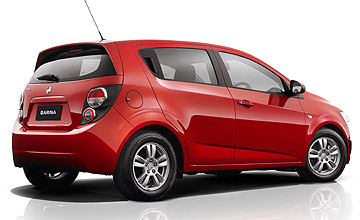BY BYRON MATHIOUDAKIS | 20th Sep 2011

In the space of just two months, two of Australia’s worst new cars have met their makers.
Both the baby Kia and littlest Holden were pretty horrible, especially in a class occupied by titans like the Ford Fiesta, Volkswagen Polo, Mazda2 and Suzuki Swift.
Now, regular readers will know that the latest Rio is really rather good, even though we’ve yet to try the important base model with its 1.4-litre engine and majority piece of the popularity pie.
But what of the latest Barina? Is it still the laughing stock of the light car class? Does it finally deserve to wear the Lion badge? Would we consider buying one? What is the capital of Peru?
To find these out and more, Holden invited us to a detailed product shakedown and a brief drive of the sixth generation Barina since 1985, through Melbourne’s eastern suburbs one wet and woolly Tuesday morning.
Now, we learned that – compared to the rubbish old TK – the latest TM series is new-from-the-ground-up except for engine, yet even that has been significantly modified for (slightly) improved performance and efficiency.
But we won’t keep you guessing – not even Holden’s gifted engineers could make this sow’s ear of an engine smooth or sweet.
Impressive on paper, with a class-leading 85kW of power, the Family One Gen III 1.6-litre four-cylinder petrol unit has a lusty, almost unbreakable feel going for it… but that’s about it.
Depressingly, just like in the old Barina, this ancient engine needs to be revved to really move, complains vocally when coaxed towards the redline, and feels coarse doing so.
Sorry, Holden. You’re in the baby-car big league now, and every competitor’s engine is better. Only when you are ambling along does it seem sufficiently competent.
While we’re at it, the five-speed manual gearbox is way off the pace too, with the usual long and rubbery throw that makes changing gears a chore, not a joy. Again, most rivals cream the Barina here.
The six-speed auto – still a rarity in this class – is a much nicer transmission, with slick changes even if the engine howls when it slips down a gear or two.
We’re no fans of the daft toggle-actuated sequential shift button (like the latest Ford Focus’) that actually feels anti-intuitive to use.
And… that’s it. The rest of the Barina is a much, much better car than before, and we would not hesitate recommending one to anybody if they are in the market for a spacious, solid, comfortable, practical and safe hatchback.
No, the steering is not the last word in quick response or feel, but it is well weighted, nicely planted at speed and doesn’t transmit too much of the wrong stuff to your palms.
We didn’t really have a chance to test the handling, but out in the ‘burbs the Barina seems tough, agile, a cinch to control, quick on the brakes and easy to park.
That feeling of solidity comes from a strong and stiff body, with doors that open and shut with a substantial thud.
Baby-car buyers will be impressed with the amount of room and the attention to detail that General Motors has gone to in making the cabin feel warm and inviting – and not toxic like the old Barina’s.
With obvious references to the Cruze and even Opel models, the central dash area is modern, appealing and very functional, with big buttons, clear markings and plenty of storage opportunities – including two gloveboxes.
The 'motorcycle-inspired’ instruments, meanwhile… well, some might find the bright analogue tachometer and big digital speedo fun and futuristic, while others will just be annoyed at how bitsy, distracting and twee it all is.
But the driving position is AOK – and is enhanced by a steering column that both tilts and telescopes (unlike a Fiesta’s nowadays).
The seats seem fine (for the 45-minute test drive anyway). Vision out is good. And you are absolutely surrounded by virtually everything you need in a modern light car – airbags, air-con, Bluetooth, audio streaming, cruise control, power windows… the lot.
The rear bench is okay too – there is the same amount of space in a modern Barina as there was in many a hatchback of the next class up from just a dozen years ago.
Note, though, that while the child seat anchorage points are correctly placed behind the rear backrest for minimum cargo space intrusion of the impressively large boot, the seat cushions do not tilt so you cannot have a flat load space right up to the rear of the front seats. But then the Barina is not alone here.
Clearly we need a lot more time to explore the TM model’s pros and cons.
What we do know is that the design is a winner – GM’s tried to make the Barina look more masculine and aggressive and we think it succeeds beautifully – and the interior works on many levels too.
Furthermore, no new car is as well equipped for the money the Holden scores a five-star ANCAP crash test rating and the Opel-based engineering shows in the big things, like the Barina’s solidity and on-road security, as well as in the little things, such as with the lane-change indicators and sturdy dash plastics.
Nope, keen drivers need not apply. And the rowdy engine and rubbery manual gearbox need to be binned immediately, but otherwise we can no longer dismiss or ignore the Barina anymore.
We do love driving so we’d pick the Fiesta, Mazda2, Polo, Swift and maybe even the Rio before it, but as a good looking and solid – if stolid – urban runabout, well, we now know you can do a whole lot worse than this.
And it’s been years since we’ve been able to say that about a Barina.